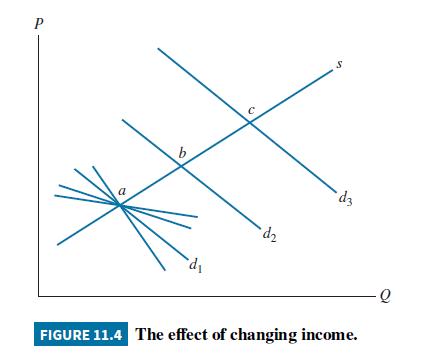In the post-World War II period, monetary policy effects and the supply and demand for money were
Question:
In the post-World War II period, monetary policy effects and the supply and demand for money were important topics. Consider the following model, where \(M\) is the money stock, \(R\) is short-term rate of interest, \(G N P\) is national income, and \(R_{d}\) is Federal Reserve's discount rate, which it charges commercial banks. The endogenous variables are the money supply, \(M\), and the short-term rate of interest, \(R\). The exogenous variables are GNP and the Federal Reserve's discount rate, \(R_{d}\). The lagged money stock \(M_{t-1}\) is a predetermined variable. It is treated as an exogenous variable and uncorrelated with the current period error. Using quarterly data from the post-war period, the 2SLS estimated money demand, omitting seasonal and other dummy variables, is

The supply equation is taken to be proportional to the difference between the short-term interest rate \(R\) and the discount rate, \(R_{d}\), with the factor of proportionality being the maximum potential money stock, \(M^{*}\), which is a known constant. The estimated supply equation, omitting seasonal and other dummy variables, is

a. If the preceding period's money supply increases by one unit, what happens to the money demand function? In a graph like Figure 11.4, with \(M\) on the vertical axis and \(R\) on the horizontal axis, does the money demand curve shift right or left or not at all? Does the money supply curve shift if \(\Delta M_{t-1}>0\) ? If so, which direction?
b. If \(G N P\) increases by one unit, what happens to the money demand function? In a graph like Figure 11.4, does the money demand curve shift right or left or not at all? Does the money supply curve shift if \(\Delta G N P_{t}>0\) ? If so, which direction?
c. If the discount rate, \(R_{d}\), is increased does the money demand curve shift right or left or not at all? Does the money supply curve shift if \(\Delta R_{d, t}>0\) ? If so, which direction?
d. Explain how your answers to (a), (b), and (c) imply that both the supply and demand for money functions are identified.
Data From Figure 11.4:-

Step by Step Answer:

Principles Of Econometrics
ISBN: 9781118452271
5th Edition
Authors: R Carter Hill, William E Griffiths, Guay C Lim




